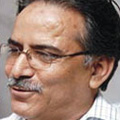
After weeks of rigorous homework, sustained activities and glorified victories, the rebellion Communists of Nepal were ready to form a democratic republic regime at Kathmandu, but their hopes turned sour with the result of Presidential and vice-Presidential races, where the law makers in the Constituent Assembly had surprisingly rejected both of their candidates. The situation turned so embarrassing for the Maoist rebels that they had decided to sit in the opposition, even though they emerged as the largest political party after the general election held during April in the Himalayan country.
Loosing the important ballot race in the Constituent Assembly for the 'Head of the State' and his subordinate, the Communist Party of Nepal-Maoist had retreated from the responsibility to form a government. Following a central committee meeting of the party on July 22, the Maoist spokesman KB Mahara declared, "After the Presidential election result comes out, it becomes clear that we do not have majority in the Assembly. Hence, we are not going to form the government."
The emergence of a three party alliance just before the Presidential polls, opposing the Maoists, even compelled the Maoist leader Pushpa Kamal Dahal alias Prachanda, who was earlier projected as the next Prime Minister of Nepal, to rethink about his next course of actions.
Prachanda, who lead a bloody revolution to end the Hindu monarchy, wanted a major share of power in the new democratic regime at Kathmandu. And for many weeks after the April 10 general election (to form the Constituent Assembly), where the Communist Party of Nepal-Maoist won highest number of seats (220), everything went on smoothly for the rebellion party.
Excited with the people's verdict, the Maoists went on demanding both the posts of President and Prime Minister for their leaders. But soon they faced the heat of democracy, when the other political parties rejected their demand out rightly. The Maoists then left their claim for the post of President but sticked to the post of an executive Prime Minister (which was reserved for Prachanda, 53).
Initially, Nepali Congress (110 members) projected its leader Girija Prasad Koirala as their candidate for the first President of Nepal. But Prachanda rejected the proposal, because he feared that a senior politician like Koirala as the President would definitely invite troubles for him (as the Prime Minister). He however described Koirala as a statesman and a National figure of Nepal, but preferred him to keep away from any heavy responsibility because of Koirala's age (he is over 80) and fragile health.
Koirala was also put under tremendous pressure by the Maoists to resign as the acting Prime Minister. After his resignation, Koirala was waiting for an elected President, who would replace the King as the ceremonial head of the state and accept his resignation letter. The Nepal Constituent Assembly on May 23 abolished the monarchy and declared the country as a democratic republic. Soon after dethroning, last King Gyanendra was even asked to leave the Narayanhiti palace, a royal and sacred place for the Nepalis.
The Presidential and Vice Presidential race in the Constituent Assembly had however changed the ambience totally. In fact, the changing situation paved way for an alliance of three political parties opposing the Maoists. During the July 19 polls in the Assembly, Maoists faced the first defeat, when their candidate Shanta Shrestha lost to Paramananda Jha, a Madhesi Janadhikar Forum (Madhesi People's Rights Forum) candidate for the post of Vice President. Jha, 73, bagged 305 votes in the 601-member Constituent Assembly to get elected for the ceremonial post.
The Madhesi community, who lives in southern Nepal that is adjacent to India, emerged as a visible political power after the general election and the community leaders asserted its space for political bargaining with the Maoists. Possessing nearly 40% population of Nepal (total populace 27 million), Madhesis, who are culturally and linguistically closed to India, were primarily demanding for autonomous rule in their locality.
The polls for President could not be completed on Saturday as no one gained the required minimum number (301) of votes. The final round of the polls held on Monday, where Ram Baran Yadav, 61, was declared elected as the first President of Nepal. Yadav, also a Madhesi candidate won the support from 308 members in the Assembly. With the support from the Nepali Congress and the Communist Party of Nepal - Unified Marxist Leninist (103 members), Yadav, a medical practitioner turned politician, defeated the Maoists backed candidate Ram Raja Prasad Singh, 74 convincingly.
The three-party alliance (Nepali Congress, Communist Party of Nepal - Unified Marxist Leninist and Madhesi People's Rights Forum) has also planned to continue their tie-up till fighting for the post of Chairman of the Constituent Assembly. Even Prachanda himself termed the alliance as 'unholy'.
It is understood that the victory of a candidate, sponsored by the combined opposition for the post of President, put Prachanda in an awkward position. He could guess, even if he takes the charge of an executive Prime Minister, Prachanda would have to face unexpected oppositions in various policy making and implementation. More over, a constant threat of toppling the government by the opposition alliance would largely loom over him.
|
|


Comments: